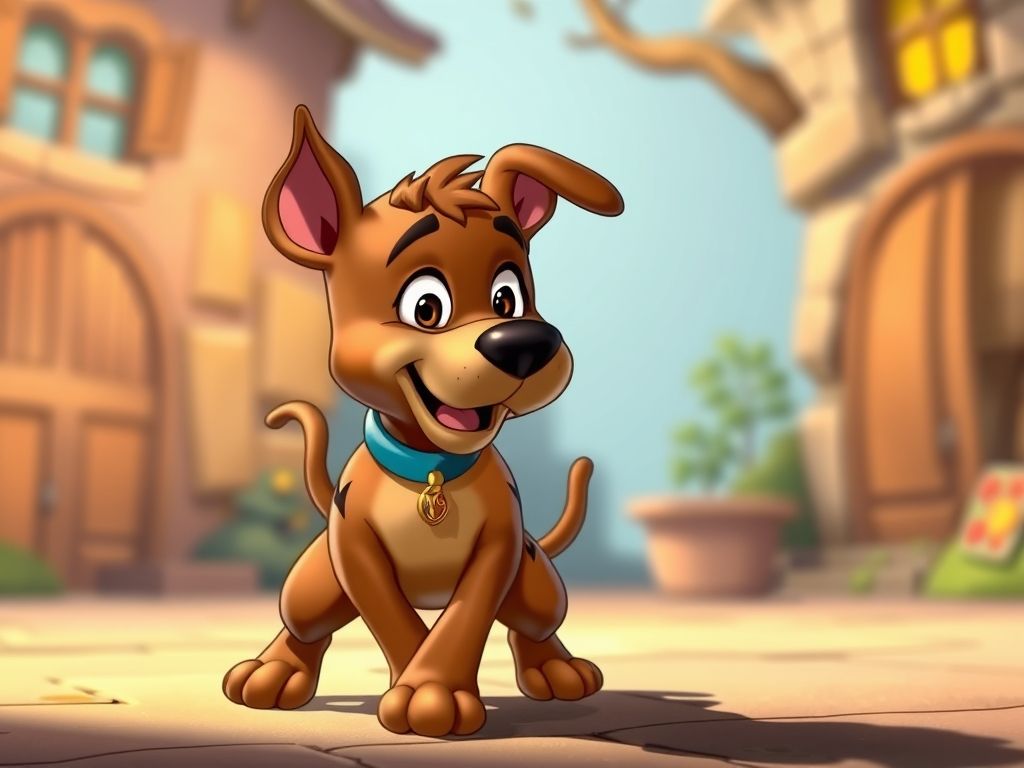Scrappy-Doo Basic Information

Scrappy-Doo, Scooby's brave little nephew, ready for action.
Scrappy-Doo
💭Cartoon Chat with Scrappy-DooCreation Info
First Appearance
September 22, 1979 (in 'Scooby-Doo and Scrappy-Doo' premiere episode 'The Scarab Lives!')
Creator
Hanna-Barbera Productions (Developed by writers including Mark Evanier, based on initial concepts by Joe Ruby & Ken Spears, character design by Iwao Takamoto)
Series
Scooby-Doo and Scrappy-Doo, The New Scooby and Scrappy-Doo Show, The 13 Ghosts of Scooby-Doo, etc.
Copyright
Hanna-Barbera Productions / Warner Bros. Discovery
Identity
Species
Dog (Great Dane)
Gender
Male
Age
Puppy
Birthday
December 20, 1979 (depicted in one episode)
Occupation
Mystery Solver (Junior Member of the gang), Professional Monster-Confronter
Scrappy-Doo's Appearance
Physical Features
Height
Small (puppy size)
Body Type
Stocky puppy build
Color Scheme
Brown fur, similar to Scooby-Doo
Signature Style
Outfit
Wears a distinctive blue collar with a diamond-shaped, golden-yellow tag bearing his initials 'SD'.
Catchphrase
"Puppy Power!", "Lemme at 'em! Lemme at 'em! I'll splat 'em!", "Ta-da-da-da-da-da, Puppy Power!", "Scrappy-Dappy-Doo!"
Accessories
Blue collar with 'SD' tag
Scrappy-Doo Character Background
Origin Story
Scrappy-Doo was introduced by Hanna-Barbera in 1979 as Scooby-Doo's nephew (son of Scooby's sister, Ruby-Doo). His creation was a direct attempt to revitalize the Scooby-Doo franchise, which was suffering from declining ratings and facing cancellation threats from ABC. Scrappy's brave and feisty personality was designed as a contrast to Scooby and Shaggy's cowardice. His personality was partly inspired by the Looney Tunes character Henery Hawk.
Character Timeline
Debut Appearance
Joined the cast in 'Scooby-Doo and Scrappy-Doo', credited with initially boosting the show's ratings.
Shift in Format
Became a central character alongside Scooby and Shaggy in various shorter-format shows and TV movies, often with Fred, Daphne, and Velma absent.
Disappearance from New Content
The character stopped appearing regularly in new Scooby-Doo productions after 'Scooby-Doo and the Reluctant Werewolf' (1988).
Live-Action Film Villain
Appeared as the surprise main antagonist in the live-action 'Scooby-Doo' movie, a meta-commentary on the character's controversial reception among fans.
Scrappy-Doo's Personality
Personality Traits
- Extremely brave and fearless, eager to confront monsters head-on.
- Highly energetic and enthusiastic.
- Feisty and determined, despite his small size.
- Impulsive and often rushes into danger without thinking.
- Idolizes his Uncle Scooby but is the opposite in terms of courage.
- Confident, sometimes overly so.
- Can be perceived as annoying or obnoxious due to his constant eagerness to fight.
- Loyal to his uncle and the gang.
Strengths
- Fearlessness and bravery.
- Surprising strength for his size.
- Unwavering determination.
- Enthusiasm (can be infectious or grating).
Weaknesses
- Recklessness; doesn't recognize danger appropriately.
- Small size makes his threats of violence comical/ineffectual.
- His aggressive eagerness can be annoying to others (both characters and audience).
- Can be naive due to his age and bravado.
Goals
- To fight monsters and villains.
- To help his Uncle Scooby and the gang solve mysteries.
- To prove his strength and bravery ('Puppy Power!').
Fears
- Very few depicted fears; seemingly fearless.
Scrappy-Doo's Gallery
Scrappy-Doo's Abilities
Special Powers
- Surprising strength for his size.
- Boundless energy.
Skills
- Charging headfirst into danger.
- Shouting catchphrases.
- (Ironically) Saving Scooby and Shaggy by dragging them away from perceived safety towards the 'monster'.
Scrappy-Doo's Relationships
Family Members
Scrappy-Doo Awards & Recognition
- While the character is controversial, his introduction initially helped the Scooby-Doo franchise avoid cancellation and continue its successful run.
Scrappy-Doo Cultural Influence
Pop Culture Impact
Scrappy-Doo is one of the most famous examples of a 'base-breaking character' or a character added to an established series who receives a strongly divided reaction from the audience. He is often cited in discussions about character additions that drastically changed a show's dynamic. His catchphrases ('Puppy Power!', 'Lemme at 'em!') are well-known, even by those who dislike the character. The term 'Scrappy Heap' is sometimes used in fandoms to refer to disliked or extraneous characters.
Social Impact
Scrappy's creation and subsequent audience reaction highlight the risks involved in altering established formulas in popular media. His transformation into a villain in the 2002 live-action film was a direct acknowledgment and parody of his divisive status among fans.
Scrappy-Doo's Theme Colors
More About Scrappy-Doo
Puppy Power!
Scrappy-Doo's most famous catchphrase is 'Puppy Power!', often exclaimed as he prepares to (or attempts to) physically confront a monster or villain. This phrase encapsulates his character: small, youthful, but brimming with misplaced confidence and eagerness to fight, a complete contrast to his Uncle Scooby's cowardice.
A Divisive Nephew
Introduced in 1979 to boost flagging ratings for the Scooby-Doo series, Scrappy-Doo was initially successful in this goal. However, over time, many older fans grew to dislike his character, finding his constant cries of 'Lemme at 'em!' and his impulsive bravery grating. The subsequent shows often focused solely on Scrappy, Scooby, and Shaggy, sidelining Fred, Velma, and Daphne, which further alienated some viewers. This led to Scrappy becoming one of the most controversial and often-disliked characters in cartoon history, famously lampooned as the villain in the 2002 live-action movie.
Scrappy-Doo In Their Own Words
Character Introduction
Ta-da-da-da-da-da, Puppy Power! Name's Scrappy-Doo! I'm Scooby-Doo's nephew, and I'm here to help Mystery Inc. catch some monsters! Lemme at 'em! Lemme at 'em!
Personality Traits
Unlike my Uncle Scooby, I ain't scared of no ghosts! Ghosts don't stand a chance with me! I'm brave, I'm tough, and I got Puppy Power! Sometimes Uncle Scooby and Shaggy try to hold me back, but I just wanna splat those monsters! Put 'em up! Put 'em up!
Classic Stories
Oh boy, I joined Uncle Scooby and the gang for all sorts of adventures! Like in 'Scooby-Doo and Scrappy-Doo,' 'The 13 Ghosts of Scooby-Doo,' and movies like 'Scooby-Doo Meets the Boo Brothers'! Wherever there was a monster, I was ready to sock 'em!
Cultural Impact
Yeah, I know, some folks find me... energetic! I was brought in to shake things up, and boy did I! Maybe I was a little too eager for some people, but hey, ya gotta admire my spirit, right? Puppy Power!